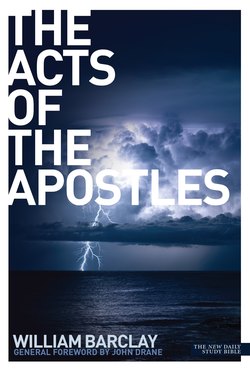Читать книгу The Acts of the Apostles - William Barclay - Страница 19
На сайте Литреса книга снята с продажи.
ОглавлениеTHE FIRST CHRISTIAN PREACHING
ACTS 2:14–42 is one of the most interesting passages in the New Testament, because it is an account of the first Christian sermon ever preached. In the early Church, there were four different kinds of preaching.
(1) There was kerugma. Kerugma literally means a herald’s announcement and is the plain statement of the facts of the Christian message, about which, as the early preachers saw it, there can be no argument or doubt.
(2) There was didache. Didache literally means teaching, and explained the meaning of the facts which had been proclaimed.
(3) There was paraklēsis, which literally means exhortation. This kind of preaching urged upon people the duty of fitting their lives to match the kerugma and the didache which had been given.
(4) There was homilia, which means the treatment of any subject or sphere of life in light of the Christian message.
Fully rounded preaching has something of all four elements. There is the plain proclamation of the facts of the Christian gospel; the explanation of the meaning and the relevance of these facts; the exhortation to fit life to them; and the treatment of all the activities of life in the light of the Christian message.
In Acts, we shall meet mainly with kerugma, because Acts tells of the proclamation of the facts of the gospel to those who had never heard them before. This kerugma follows a pattern which repeats itself over and over again all through the New Testament.
(1) There is the proof that Jesus and all that happened to him is the fulfilment of Old Testament prophecy. In recent years, less and less stress has been laid on the fulfilment of prophecy. We have come to see that the prophets were not nearly so much foretellers of events to come as forthtellers of God’s truth. But this stress of early preaching on prophecy conserved the great truth that history is not haphazard and that there is meaning to it. To believe in the possibility of prophecy is to believe that God is in control and that he is working out his purposes.
(2) In Jesus the Messiah has come, the messianic prophecies are fulfilled and the new age has dawned. The early Church had a tremendous sense that Jesus was the hinge of all history; that, with his coming, eternity had invaded time; and that, therefore, life and the world could never be the same again.
(3) The kerugma went on to state that Jesus had been born of the line of David, that he had taught, that he had worked miracles, that he had been crucified, that he had been raised from the dead and that he was now at the right hand of God. The early Church was sure that the Christian religion was based on the earthly life of Christ. But it was also certain that that earthly life and death were not the end and that after them came the resurrection. Jesus was not merely someone about whom they read or heard; he was someone whom they met and knew, a living presence.
(4) The early preachers went on to insist that Jesus would return in glory to establish his kingdom upon earth. In other words, the early Church believed intensely in the second coming. This doctrine has to some extent passed out of modern preaching; but it does conserve the truth that history is going somewhere and that some day there will be a completion and fulfilment and that people are therefore in the way or on the way.
(5) The preaching finished with the statement that only in Jesus was salvation possible, that those who believed on him would receive the Holy Spirit and that those who would not believe were destined for terrible things. That is to say, it finished with both a promise and a threat. It is exactly like that voice which John Bunyan heard, as if coming from right behind him, demanding: ‘Wilt thou leave thy sins and go to heaven, or wilt thou have thy sins and go to hell?’
If we read through Peter’s sermon as a whole, we will see how these five strands are woven into it.
